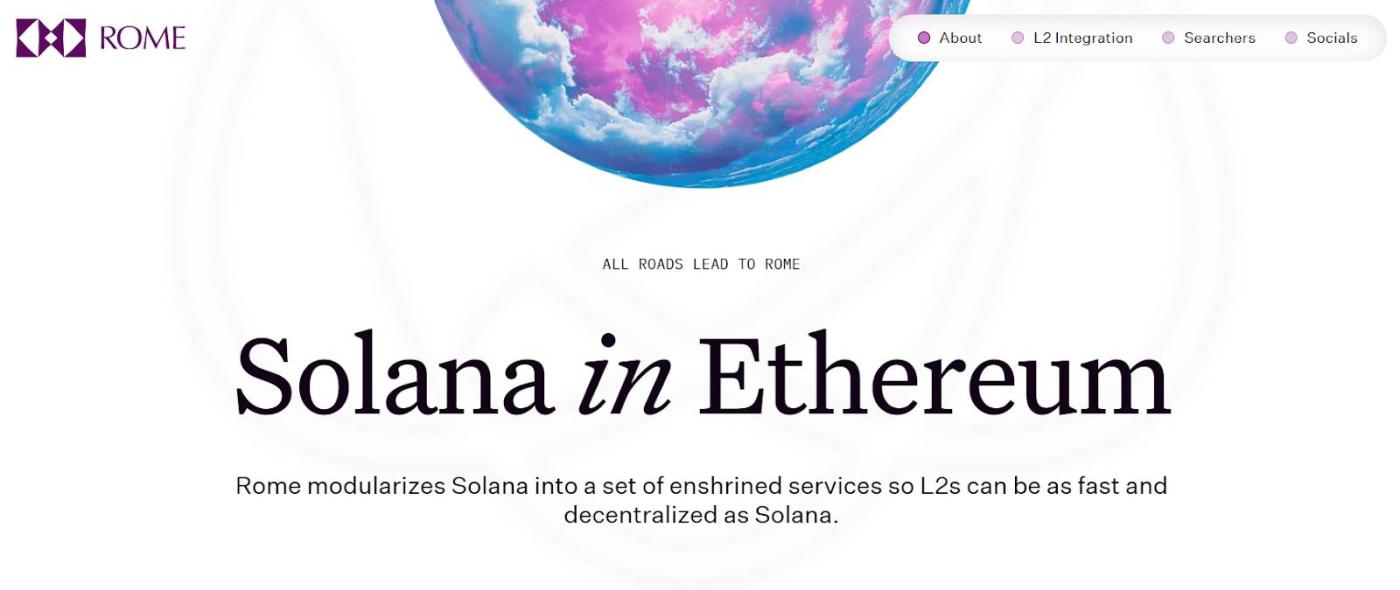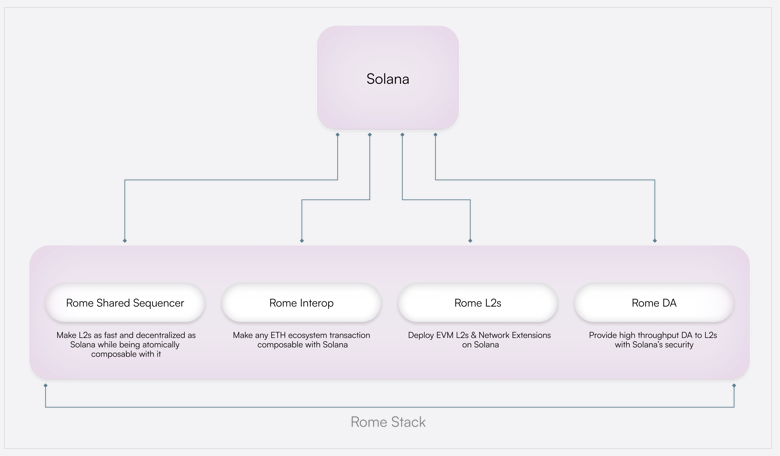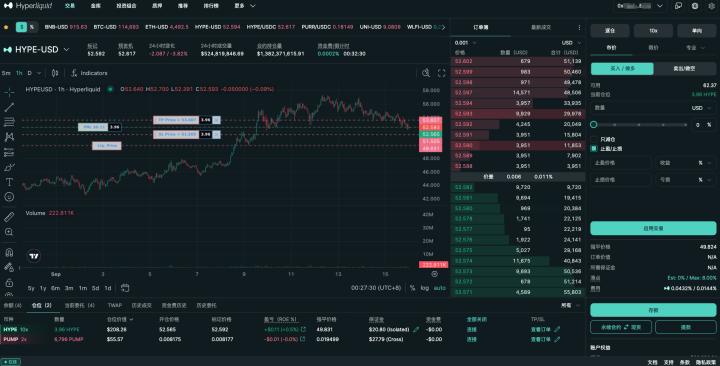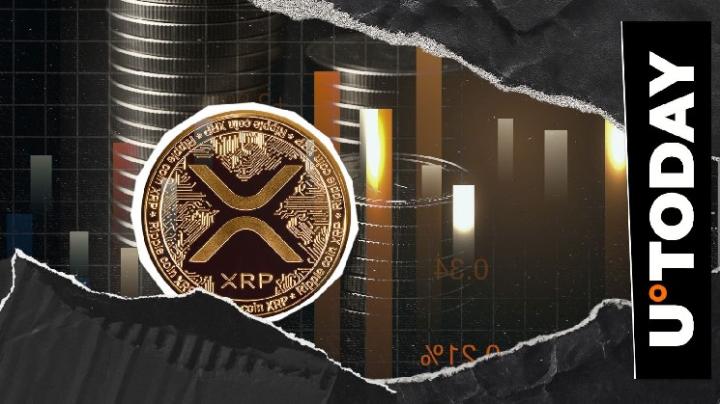 What is Rome Protocol?
What is Rome Protocol?
Rome Protocol is a project on the Solana blockchain that builds a shared sequencer layer for Ethereum rollups, but unlike most, Rome runs on Solana and uses Neon EVM as the execution environment for each rollup. The idea: take advantage of Solana 's high throughput, low fees, and fast confirmation times to sequence and execute transactions of L2 EVMs—then "settle" them on Ethereum.
In the Rome architecture, each rollup is deployed as a Neon EVM “instance” on Solana; Solana Vai as the “global state machine”, and Ethereum is the finality/settlement. This approach aims to: Better extensibility, low cost, and unlocks composability between EVM rollups across the same sequencer layer.
Imagine Ethereum as a very prestigious but overcrowded central court, so each time a file (transaction) is processed, it takes a long time and costs a lot of money. The “rollups” are like branch offices that receive the files first and then send them back to the court for final confirmation. Rome Protocol Vai as a “common express post office” for all these branches: they collect the files from many offices, arrange them in a clear order and process them quickly on Solana – which is like a high-speed, low-cost data processing center. Once everything is done, the results are sent back to the Ethereum “central court” for official stamping. Thanks to that, users will have a faster and cheaper experience while still being guaranteed the security of Ethereum.
Architecture & Core Components
Rhea (Shared Sequencer): receive transactions from rollup, package into Rome/ Solana tx, send to Solana to be sorted on “first come, first served” basis. Ordering on Solana makes transaction order immutable.
Solana (Global State Machine): Decide the tx order and update the rollup status on Solana in advance, so users can receive “pre-confirmations” quickly.
Hercules (Executor): receive the Block sorted by Solana and execute the payload on each rollup to “advance the state”; the Merkle root and tx order are then sent back to Ethereum for settlement.
 Rome Protocol Infrastructure
Rome Protocol InfrastructureData Availability (DA): Rollup data can be published on Solana, Celestia, or Ethereum depending on configuration (trade-off between cost and security).
In addition to the “shared sequencer”, Rome also offers:
Rome EVM & Rome L2 Stack (OP Geth + tooling): allows to spin up a L2 EVM and deploy EVM dApps directly on Solana.
Rome Interop / SDK: build transactions atomic cross-rollup between L2 Rome and Solana.
Nexus (Based Sequencing): “based rollups” variant—where L1 proposer (Ethereum) can include rollup Block (built by Solana/Rome) in the next L1 Block , to inherit L1 Liveness/decentralization and increase fairness.
Why “build” on Solana?
Throughput & Latency: Solana ’s PoH/performance characteristics allow Rome to batch transactions from multiple rollups with low latency, giving rollup users the “L1 Solana fast” feel before settling on Ethereum.
Expense: cheaper than running a separate sequencer for each rollup; Chia infrastructure enables economies of scale.
Composability: Chia a sequencer layer → easy liquidation matching, atomic swap/cross-rollup, more transparent MEV/searcher operations.
 How Rome Protocol Works
How Rome Protocol WorksTeam & Investors
Co-founders: Anil Kumar (finance background/PM at JPMorgan, Deutsche) and Sattvik Kansal (engineer, formerly at Google/Cornell).
Call for Capital: July 2024, Rome mobilizes 9 million USD (seed), with participation from Hack VC, HashKey, Portal Ventures, Bankless Ventures, Robot Ventures, Polygon Ventures… and angels like Anatoly Yakovenko.
Projects in the same field
Rome Protocol can be envisioned as a “common infrastructure layer” similar to Astria, Espresso or Radius – all pursuing the goal of creating shared sequencer , a shared transaction ordering layer to reduce dependency on a centralized sequencer, increasing fairness and availability for rollups. Rome's big differentiator is that Place the main processing block on Solana instead of relying solely on Ethereum or other EVM-compatible networks.
Rome chooses Solana does the execution/state machine for EVM rollups—an approach that few projects take due to its “ecosystem-heterogeneity” nature, but if done well can take advantage of Solana performance while maintaining finality on Ethereum.
Risks & Challenges
Rome Protocol faces a few key challenges: first, it relies on the Solana infrastructure — if the Solana network goes down, it could temporarily affect the sequencing or confirmation of transactions, even though they will eventually settle on Ethereum. Second, cross- chain security and Data Availability (DA) issues must be handled very carefully — DA configurations, fraud proofs, or validity proofs need to be fully tested and audited before mainnet to avoid data corruption or misordering of transactions.
Conclude
Rome Protocol is shaping a new infrastructure bridge that combines the fast and low-cost processing power of Solana with the safety and finality of Ethereum. With its sequencing and execution model on Solana but settled on Ethereum, and its toolkit supporting L2 EVM creation and cross- chain connectivity, Rome has the potential to become the foundational layer that enables multiple EVM rollups to run smoothly, expand interoperability, and bring a “ Solana speed” experience to assets and transactions in the Ethereum ecosystem.






